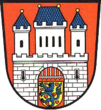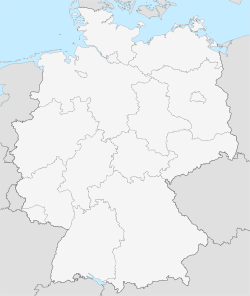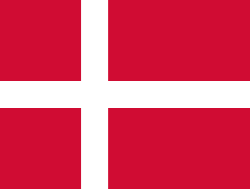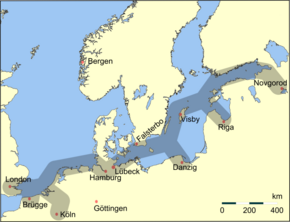Lüneburg
| Lüneburg | |
| Coat of arms | Location |
 |
 |
| Administration | |
| Country | Germany |
|---|---|
| State | Lower Saxony |
| District | Lüneburg |
| Town subdivisions | 14 districts |
| Lord Mayor | Ulrich Mädge (SPD) |
| Basic statistics | |
| Area | 70.34 km² (27.2 sq mi) |
| Elevation | 17 m (56 ft) |
| Population | 72,057 (30/12/2006) |
| - Density | 1,024 /km² (2,653 /sq mi) |
| Other information | |
| Time zone | CET/CEST (UTC+1/+2) |
| Licence plate | LG |
| Postal codes | 21335–21337–21339 |
| Area code | 04131 |
| Website | www.lueneburg.de |
Lüneburg, also known as Lueneburg and Lunenburg in English, is a city in Lower Saxony, Germany. The city is located about 45 km (30 miles) southeast of Hamburg. It is part of the Hamburg Metropolitan Region and one of Hamburg's inner suburbs. The capital city of the district of Lüneburg, it has a metropolitan population of 103 000, including the surrounding communities like Adendorf, Bardowick and Reppenstedt. Since 2007, Lüneburg is officially allowed to use the title "Hansestadt" (Hanseatic city) in recognition of its membership in the former Hanseatic League. The official name of the city is now Hansestadt Lüneburg (Hanseatic City of Lüneburg).
Contents |
Geography
The Ilmenau River, a tributary of the Elbe, flows through Lüneburg.
History
The ancient town is probably to be identified with Leufana or Leuphana (Greek: Λευφάνα), a town listed in Ptolemy (2.10) in the north of Germany on the west of the Elbe, but this identification is not universally accepted. Lüneburg was first mentioned in 956 in a contract between monks living at the location and the Holy Roman Emperor.
The town became remarkably rich during the Middle Ages due to the salt deposits around the town. Several salterns existed around the town, and the salt was exported to the neighbouring fiefs for use as a spice and food preservative. It was also exported along the Old Salt Route via Lauenburg to Lübeck, from where it was shipped to all the cities along the Baltic coast; this salt trade made the city rich. Lüneburg was for a long time one of the capitals of the dukes of Brunswick-Lüneburg; the town and its salt were major factors of power and wealth of the Hanseatic League.
After a long period of prosperity, its importance began to decline around 1600. The town became part of the Electorate of Hanover in 1708, the Kingdom of Hanover in 1814, and the Prussian Province of Hanover in 1866. After World War II, it became part of the new state of Lower Saxony.
The salt mine was closed in 1980, ending the thousand-year tradition of salt mining, though small amounts are still mined for ceremonial purposes. The town gained new relevance from its university, which was founded in 1989, and is a popular tourist destination within Germany because of the Lüneburg Heath, a unique landscape created by the deforestation of the surrounding area for firewood for the fires used in the obtaining of salt.
The Polabian name of Lüneburg is Glain (spelled Chlein or Glein in older German reference material), which is propably derived from glaino (< Slavic *glina), meaning ‘mud’ or ‘clay’.
Infrastructure
- Hospitals: Stätisches Krankenhaus Lüneburg, Landeskrankenhaus Lüneburg
- Theaters: Theater Lüneburg
- Movie theaters: Cinestar, Scala Kino
- Hotels: 8
- Museums: 8
- Transport: Lüneburg is part of the transportation company Hamburger Verkehrsverbund. There are 11 bus lines in the urban area of Lüneburg. The city has a main railroad station and a smaller one located in Bardowick. The next bigger cities within easy reach by train are Hamburg, Hannover, Lübeck, Lauenburg, Uelzen and Winsen.
Education
- Universities: Leuphana Universität Lüneburg
- Schools:
- Gymnasien: 5
- Realschulen: 4
- Hauptschulen: 5
- Gesamtschulen: 0
- vocational schools: 6
- special schools: 3
- private schools: 3
- elementary schools: 12
Sports
Football (soccer) is the most popular sport in Lüneburg, as in Germany in general; ice-hockey and basketball are popular as well. The most teams compete in the Regionalliga, which is highly ranked within Germany.
- Football: FC Hansa Lüneburg(former Lüneburger SK), Oberliga
- Basketball: MTV Treubund Lüneburg, 2.Regionalliga (Women) Stadtliga (Men)
- Ice-hockey: Adendorfer EC, Regionalliga
- Handball: HSG Lüneburg, Regionalliga
- Volleyball: SVG Lüneburg, Regionalliga
- Baseball: Lüneburg Woodlarks, Regionalliga
- American Football: Lüneburg Jayhawks, Oberliga
Interesting facts
- Lüneburg has the second most bars per mile and per resident in Europe after Madrid, Spain; it has the most bars per resident in Germany.
- The buildings in downtown Lüneburg survived from the 16th century on, escaping destruction even during the Second World War. As a result, the downtown district looks very old, and its rare state of preservation, along with the beauty of the surrounding Heath, attracts many tourists to the city.
- The most populated district (10000) is Kaltenmoor, which is known for much violence, crime and unemployment.
- The city has a very famous and active (legal) Graffiti scene and is home to many Graffiti Halls of Fame.
- On May 23, 1945, the Nazi war criminal Heinrich Himmler is believed to have commited suicide in Lüneburg after he had been captured by the British Army. He swallowed a potassium cyanide capsule before his interrogation could begin; his body was found in his cell. His body is buried in a nearby forest in an unmarked location. As the dead man lacked a fencing scar that was prominent on Himmler's face, there have been a few attempts to question the identification of the man as Himmler.
Sister Cities
 Scunthorpe, England.
Scunthorpe, England. Clamart, France.
Clamart, France. Naruto, Tokushima, Japan.
Naruto, Tokushima, Japan. Ivrea, Italy
Ivrea, Italy Viborg, Denmark
Viborg, Denmark Tartu, Estonia
Tartu, Estonia
Gallery
Notable people
- Fritz Heinemann
- Esther Marie Mengelkamp
- Bernhard Riemann — studied for his Abitur at the Johanneum Lüneburg
- Mike Mareen - Successful Disco artist who grew up in Lüneburg.
- J S Bach - Bach attended the Lüneburg school and sang in its choir[1][2]
- Katarina Waters, also known as Katie Lea Burchill in WWE - a professional wrestler
References
- This article incorporates text from the public domain Dictionary of Greek and Roman Geography by William Smith (1856).
- ↑ The New Bach Reader, p37
- ↑ http://jan.ucc.nau.edu/~tas3/luneburg.html - "Johann Sebastian and a friend Georg Erdmann turned their steps toward the north, both boys carrying all their worldly belongings in a two-hundred mile trek to Lüneburg. At the Michaelisschule their duties were to sing in the church choir on Sundays...".
See also
- Brunswick-Lüneburg
- Lüneburg-Celle
- Lüneburg Heath
External links
- Official website (German)
- Official website (English)
- Leuphana University (German)
|
||||||||||||||||||||||||||
|
|||||||

